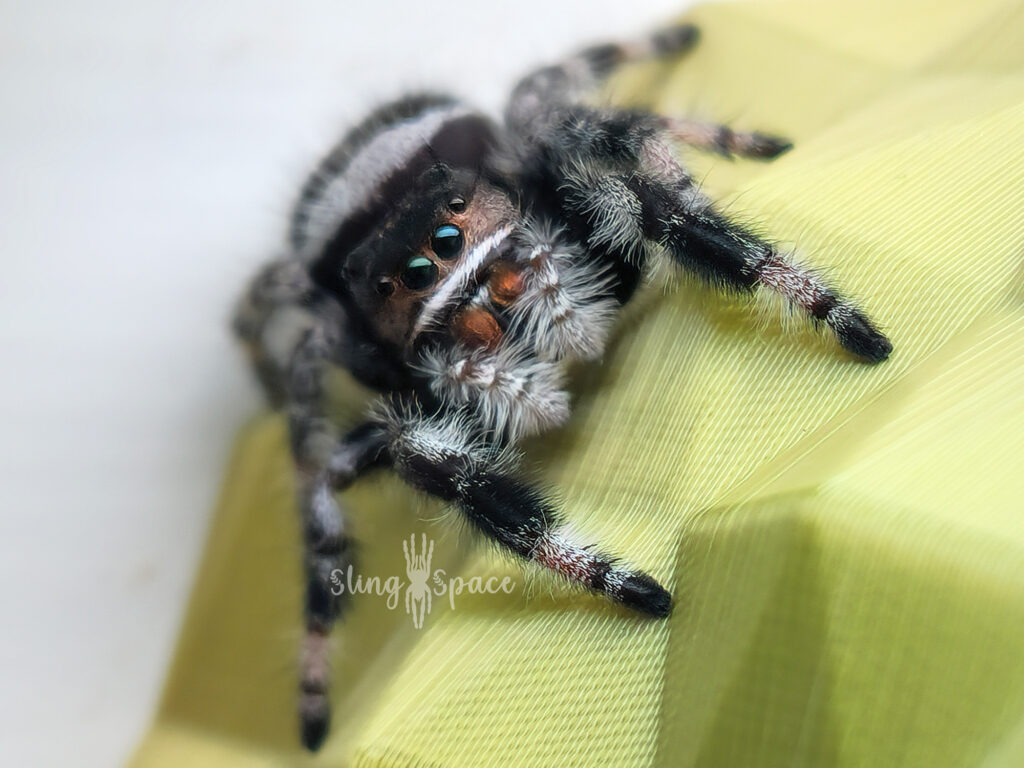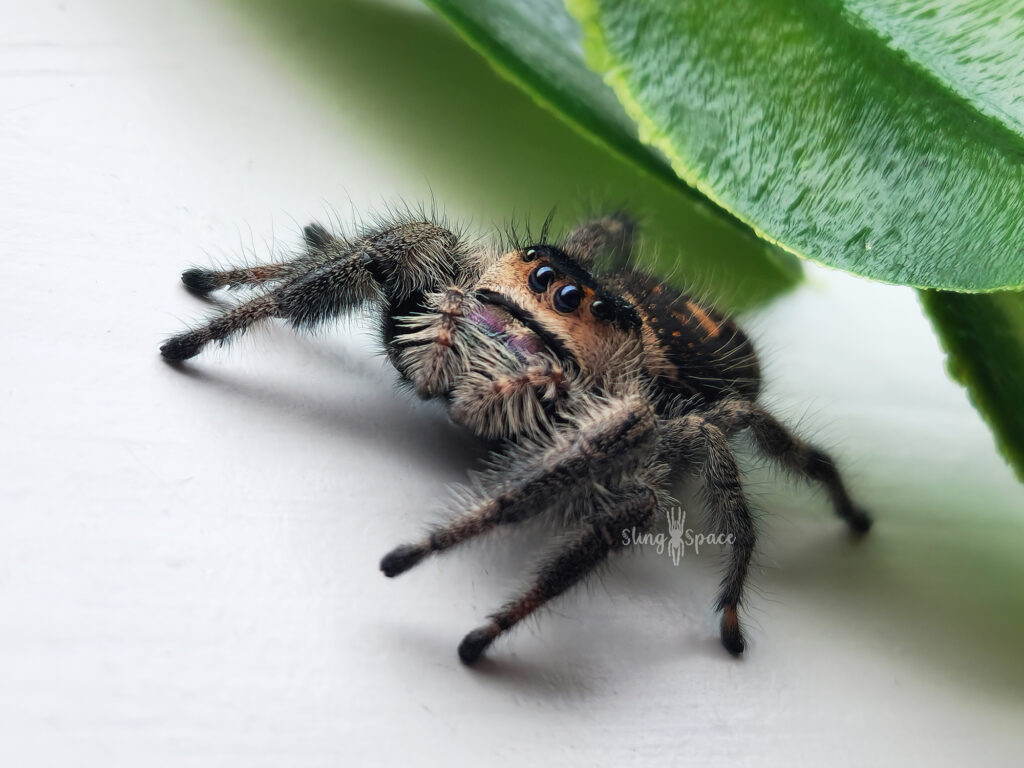Jumping spiders have fast become a popular pet amongst invert keepers both new and old! As breeders we want to provide our tiny friends with the best possible lives, so we have created a comprehensive care guide.
Please note! This guide is aimed at Phidippus regius (regal jumping spiders) in particular. Care is the same for Phidippus audax (bold jumping spiders), however other jumping spider species needs may differ.
Click on a topic below to jump to that section!
- Housing
(Enclosure Setup, Lighting, Decoration) - Feeding
(Water, Feeding) - Lifecycle
(Slings, Adults, Seniors) - Eggsacks
(What to know!)
Housing
Enclosure Setup
Jumping spiders are arboreal, which means they like to climb high. For this reason we recommend an enclosure that is taller than it is wide. They like to build their web hammocks at the tallest point in their enclosure, so it’s important to consider setting up their home in a way that won’t destroy their webbing every time you open then enclosure. We’ve found that top or front opening enclosures work best! Proper cross ventilation is important to allow for good air flow and prevent moisture building up in the habitat which could lead to mold.
Adults will be happy in a 4x4x8 inch enclosure, but go as large as you like! For small slings we recommend starting off smaller, as this makes it easier for them to find their prey while learning how to hunt.
Light
Jumping spiders enjoy light and benefit from a natural daylight cycle. Ambient daylight within a room, or LEDs on a 12-hour timer are recommended. It is important not to place their enclosures in direct sunlight as they may get too hot. 70 – 85 degrees Fahrenheit is adequate for these species and they do not usually need any additional heating unless your house runs cold!
Decoration
Decorating your enclosure is not only fun, but provides your spider with the environment they need to thrive! It is important to provide your spider with a ‘hide’; somewhere where they can get out of view and feel safe. Hides are best placed near the top of the enclosure and will generally become a main webbing spot.
Other decoration can include fake flowers, cork bark, rocks, etc. It is important to wash any items before placing them into your spider’s home. Any natural items such as sticks or rocks from outside should be baked to sanitize them and kill off any mold spores or parasites before being used as decor. We usually bake at 250f for 30 minutes to one hour.
Wooden items should be sealed with a non-toxic waterproof sealant to prevent mold growth and allowed to dry/cure for a minimum of 48 hours. Care should be taken to not get these items intentionally wet even when sealed. Mold can, and will, grow on sealed wooden decor if it is frequently misted!
Spot cleaning as needed can be done with a wet q-tip or paper towel to remove any poop spots, and discarded food ‘husks’ should be removed daily.
Substrate is optional, but we generally like to use a coconut fiber ‘bedding’ to encourage some humidity retention and provide a soft landing spot in case of falls. It is recommended to change it out regularly to prevent mold and bacteria growth.
Feeding
Water
Jumping spiders generally will not drink from a water dish like tarantulas, so most keepers prefer to use a spray bottle to provide water every 2-3 days. Lightly mist one side of your spider’s enclosure enough to leave small droplets; your spider will drink these! Make sure that the droplets are smaller than your spider so that they do not risk getting stuck in the water tension.
Try not to get too much water spray on your decor or substrate. A very humid environment will encourage mold growth which can harm your spider! If you do notice mold, remove any affected items immediately and thoroughly wipe down the enclosure.
Food
Very young jumping spiders (or ‘slings’) will start on a diet of Melangoster fruit flies at around i2 when they start to leave the nest. Offer 3-5 flies once every other day. As they molt and grow, you can begin to introduce larger prey such as Hydei fruit flies or mealworm larvae.
At around the i6 size you can offer larger prey, and less frequently. We love to feed baby Dubia roaches as they are easy to keep and won’t harm your spider. Other foods include mealworms, bluebottle flies, waxworms, and small crickets.
CAUTION. Crickets can be aggressive towards spiders and can harm or kill them. If using crickets as your feeders, watch carefully during feeding time to make sure that your jumping spider has killed its prey. If your spider is not hungry, remove the cricket. Never leave crickets in unsupervised otherwise you risk coming back to a dead spider.
Lifecycle
You’ll often see the terms ‘i1’ through ‘i9’ when reading about jumping spiders. The ‘i’ stands for ‘instar’, which is the life stage between each molt! i1 is their first molt within the nest, and at their second molt (i2) slings will generally start leaving the nest to explore. They are still kept communally at this point.
At around i4 or i5, slings should be separated and live alone. If left in a group at this stage they will start to cannibalize each other.
i8 is generally considered sub adult, and at this age you should have a large, well established spider!
Regal jumping spiders will have about 9 – sometimes 10 – molts before hitting maturity at around 14-16 months old. A mature spider can now breed and will not molt again. Males will have larger comma-shaped pedipalps, and females will have a visibile epigynum which looks like a small shiny bellybutton on their abdomen. They can live for another 1 to 2 years after maturing!
Eggsacks
[coming soon]
